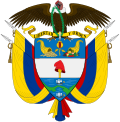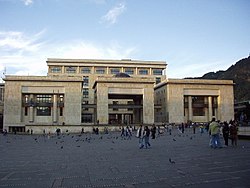| Party | Votes | % | Seats |
|---|
| Historic Pact for Colombia | 2,922,409 | 17.62 | 28 |
| Colombian Liberal Party | 2,335,426 | 14.08 | 32 |
| Colombian Conservative Party | 2,068,076 | 12.47 | 25 |
| Democratic Center | 1,692,491 | 10.20 | 16 |
| Union Party for the People | 1,439,579 | 8.68 | 15 |
| Radical Change | 1,319,437 | 7.95 | 16 |
| Green Alliance | 1,093,836 | 6.59 | 11 |
| Hope Center Coalition | 445,549 | 2.69 | 2 |
| MIRA–Fair and Free Colombia | 288,617 | 1.74 | 1 |
| New Liberalism | 282,271 | 1.70 | 1 |
| League of Anti-Corruption Governors | 172,342 | 1.04 | 2 |
| Historic Pact–Green Alliance | 149,218 | 0.90 | 2 |
| Radical Change–Fair and Free Colombia–MIRA | 136,622 | 0.82 | 1 |
| Colombian Conservative Party–Union Party for the People | 111,497 | 0.67 | 1 |
| Colombian Conservative Party–Democratic Center | 99,138 | 0.60 | 1 |
| Radical Change–MIRA | 84,704 | 0.51 | 1 |
| Civic Force | 71,075 | 0.43 | 1 |
| Colombian Liberal Party–Fair and Free Colombia | 68,468 | 0.41 | 1 |
| Colombia Renaissance Party | 62,490 | 0.38 | 1 |
| Alternativos (AV–PDA) | 60,527 | 0.36 | 2 |
| Union Party for the People–MIRA–Fair and Free Colombia | 60,412 | 0.36 | 0 |
| Radical Change–Fair and Free Colombia | 58,674 | 0.35 | 0 |
| Independent Movement of Absolute Renovation | 56,911 | 0.34 | 0 |
| Gente en Movimiento | 54,933 | 0.33 | 1 |
| National Salvation Movement | 38,123 | 0.23 | 0 |
| Together for Caldas (ASI–D–NL–MIRA) | 36,479 | 0.22 | 1 |
| Radical Change–CJL–MIRA–Union Party for the People | 34,743 | 0.21 | 0 |
| MIRA–Democratic Center–Fair and Free Colombia | 32,514 | 0.20 | 0 |
| AV–Hope Center Coalition | 31,873 | 0.19 | 0 |
| Union Party for the People–MIRA–CJL–ASI | 30,022 | 0.18 | 0 |
| Colombian Conservative Party–CJL–MIRA | 29,947 | 0.18 | 0 |
| Human Colombia Political Movement | 29,845 | 0.18 | 0 |
| Colombian Conservative Party–CJL–MSN | 24,162 | 0.15 | 0 |
| Commons | 21,423 | 0.13 | 5 |
| MIRA–CJL–MSN | 18,165 | 0.11 | 0 |
| Dignity | 16,431 | 0.10 | 0 |
| Independent Social Alliance | 12,765 | 0.08 | 0 |
| MIRA–Democratic Center | 11,688 | 0.07 | 0 |
| Union Party for the People–MIRA–Radical Change | 9,549 | 0.06 | 0 |
| Union Party for the People–Fair and Free Colombia | 6,612 | 0.04 | 1 |
| The Change is Me Digital Movement | 6,234 | 0.04 | 0 |
| Colombian Liberal Party–Independent Social Alliance | 4,018 | 0.02 | 0 |
| Force Colombia (Colombia Renaissance Party–ASI) | 2,371 | 0.01 | 0 |
| National Salvation Movement–Fair and Free Colombia | 1,853 | 0.01 | 0 |
| Indigenous Authorities of Colombia | 629 | 0.00 | 0 |
| Fair and Free Colombia | 41 | 0.00 | 0 |
| Vice-presidential runner-up | | 1 |
| Blank votes | 1,053,480 | 6.35 | – |
| Total | 16,587,669 | 100.00 | 169 |
|
| Valid votes | 16,587,669 | 93.17 | |
|---|
| Invalid/blank votes | 1,215,344 | 6.83 | |
|---|
| Total votes | 17,803,013 | 100.00 | |
|---|
| Registered voters/turnout | 38,819,901 | 45.86 | |
|---|
| Afro-Colombian seats |
|---|
| Palenque de la Vereda las Trecientas y del Municipio de Galapa | 66,474 | 14.07 | 1 |
| Fernando Ríos Hidalgo | 40,049 | 8.48 | 1 |
| CC de la Comunidad Negra Limones | 39,924 | 8.45 | 0 |
| CC La Toma | 25,602 | 5.42 | 0 |
| CC Manuel Zapata Olivella De San Antero | 25,322 | 5.36 | 0 |
| CC Afrozabaletas | 20,189 | 4.27 | 0 |
| CC de la Costa Pacífica "Concosta" | 12,605 | 2.67 | 0 |
| CC Bocas del Atrato y Leoncito | 12,306 | 2.60 | 0 |
| CC la Voz de Los Negros | 11,730 | 2.48 | 0 |
| CC de Comunidades Negras De Guayabal | 11,081 | 2.35 | 0 |
| Organización Étnica de Comunidades Afros los Palenkes | 9,285 | 1.97 | 0 |
| CC Mayor de Casimiro | 7,834 | 1.66 | 0 |
| CC Mayor de Certegui | 7,654 | 1.62 | 0 |
| CC de Comunidades Negras de Campo Hermoso | 6,181 | 1.31 | 0 |
| Partido Colombia Renaciente | 6,152 | 1.30 | 0 |
| CC Bocas de Taparal | 5,270 | 1.12 | 0 |
| Somos Identidad | 5,031 | 1.06 | 0 |
| Movimiento Alianza Democrática Amplia | 4,298 | 0.91 | 0 |
| CC Integral de Lloró | 4,263 | 0.90 | 0 |
| CC de la Comunidad Negra de Villa Gloria | 4,074 | 0.86 | 0 |
| CC Veredas Unidas un Bien Común | 4,056 | 0.86 | 0 |
| CC Unión Patía Viejo | 4,015 | 0.85 | – |
| CC del Río Guajuí | 3,963 | 0.84 | 0 |
| Consejo Comunit Piedras Bachichi Correg Santa Cecilia | 3,613 | 0.76 | 0 |
| Fundación para el Desarrollo Social de Comunidades Negras | 3,356 | 0.71 | 0 |
| Alianza Nacional Afrocolombiana | 2,976 | 0.63 | 0 |
| CC de Comunidades Negras Socolando | 2,942 | 0.62 | 0 |
| CC Rio Curbaradó | 2,681 | 0.57 | 0 |
| Conmoguz | 2,456 | 0.52 | 0 |
| CC de Flamenco - Municipio de María La Baja | 2,330 | 0.49 | 0 |
| Asoc Afrocol Desplazados Mcpio Guacarí Valle del Cauca "ADAG" | 2,322 | 0.49 | 0 |
| CC Alto Paraíso | 2,296 | 0.49 | 0 |
| CC Puerto Girón | 2,147 | 0.45 | 0 |
| CC Arcilla, Cardón y Tuna | 2,113 | 0.45 | 0 |
| Consejo Mayor Condoto Iró | 1,923 | 0.41 | 0 |
| CC de Vuelta Manza | 1,860 | 0.39 | 0 |
| Consejo Comunit Recuerdo de Nuestros Ancestros Rio Mejicano | 1,804 | 0.38 | 0 |
| CC de los Corregimientos de San Antonio y El Castillo Municipio de El Cerrito | 1,750 | 0.37 | 0 |
| CC Rescate Las Varas | 1,687 | 0.36 | 0 |
| CC del Guabal | 1,624 | 0.34 | 0 |
| Corporación Kofi Annan | 1,594 | 0.34 | 0 |
| Corporación De Educadores del Litoral Pacifico Corelipa | 1,186 | 0.25 | 0 |
| Afromutata | 1,087 | 0.23 | 0 |
| Asociación Afrodescendientes de Arboletes | 996 | 0.21 | 0 |
| Coacneja | 937 | 0.20 | 0 |
| Fundación Social Magende Mi | 633 | 0.13 | 0 |
| Odeprivicor | 542 | 0.11 | 0 |
| Comunidad de Negros de Aguas Blancas | 404 | 0.09 | 0 |
| Blank votes | 87,809 | 18.59 | – |
| Total | 472,426 | 100.00 | 2 |
|
| Valid votes | 472,426 | 83.86 | |
|---|
| Invalid/blank votes | 90,917 | 16.14 | |
|---|
| Total votes | 563,343 | 100.00 | |
|---|
| Indigenous seat |
|---|
| Indigenous and Social Alternative Movement | 84,637 | 42.26 | 1 |
| Indigenous Authorities of Colombia | 27,089 | 13.52 | 0 |
| Colombian Indigenous Party | 18,828 | 9.40 | 0 |
| National Association of Cabildos and Indigenous Authorities in Colombia | 7,957 | 3.97 | 0 |
| Aywjawashi Indigenous Council | 7,870 | 3.93 | 0 |
| Resguardo Indígena Alta y Media Guajira | 5,556 | 2.77 | 0 |
| Resguardo Indígena Zenú Del Alto San Jorge | 2,900 | 1.45 | 0 |
| Blank votes | 45,459 | 22.70 | – |
| Total | 200,296 | 100.00 | 1 |
|
| Valid votes | 200,296 | 84.29 | |
|---|
| Invalid/blank votes | 37,338 | 15.71 | |
|---|
| Total votes | 237,634 | 100.00 | |
|---|
| Source: [13] |








